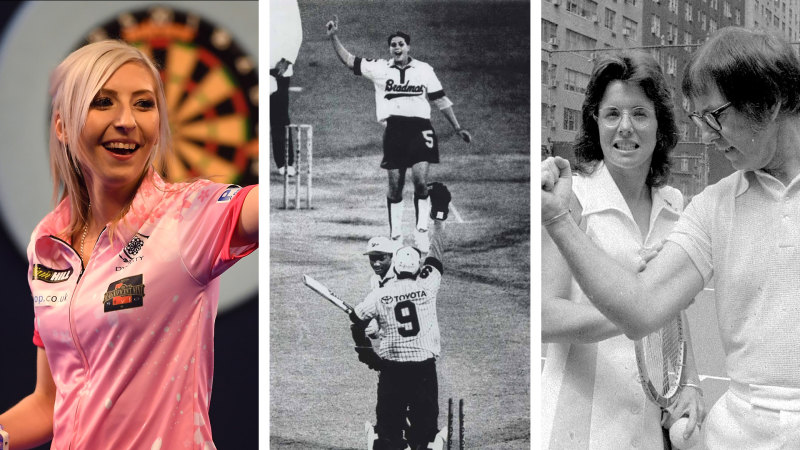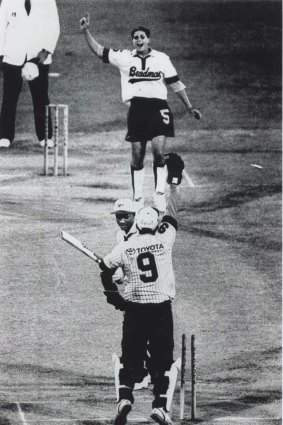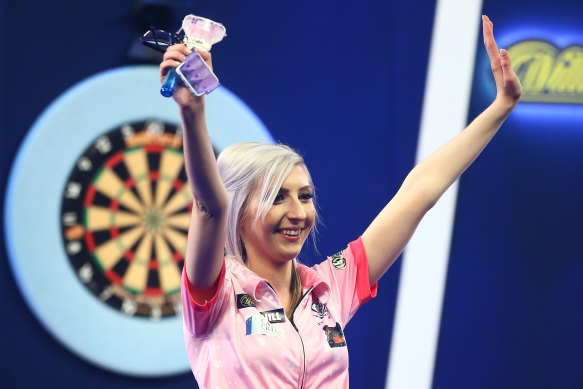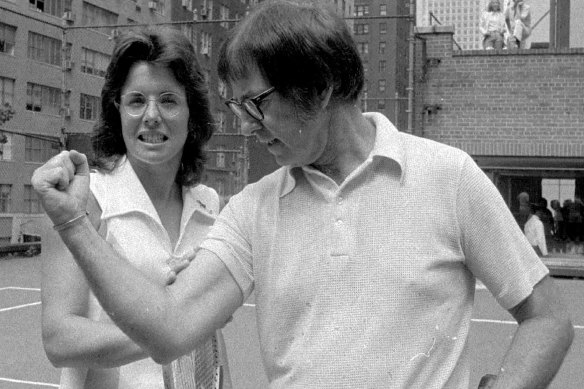Save articles for later
Add articles to your saved list and come back to them any time.
Which brings us to trans athletes in spor …
Yeah, nah … just kidding!
Look, I am generally happy to wade into that subject despite the fatigue of subsequently dealing with three days of earnest trolls. But, just this once, and one postcode over, can we talk about why it is that there are so few sporting comps where men and women don’t compete on an even playing field?
We already know that the world leans forward on the odd occasion it does happen, that it brings a fresh audience eager to see the genders competing, even if the sport itself might not interest them.
When, in 1973, in the famed “Battle of the Sexes” tennis match, Bobby Riggs played first Margaret Court and then Billie Jean King – smashing the former and losing to the latter – it was a front-page story around the world. It captured the public imagination and no fewer than 90 million people tuned into the second match.
Zoe Goss bowls Brian Lara.Credit: Tim Clayton
Similarly, when Zoe Goss took Brian Lara’s wicket in a charity match in 1994, the cricket world lost its collective nut. The headlines went for weeks, and a statue was commissioned in Goss’ honour. The idea that in a sporting competition that relied on fine skill not just brute strength, a woman could beat a man, was fabulous. And few other single moments have so captured the public imagination in Australia’s sporting history.
So here’s what I don’t get.
Given the level of interest generated by that very dynamic, why don’t we see sporting federations and entrepreneurs pushing for more open integrated competition?
Why, for example, do we have a men’s and a women’s chess competition?
Why bother with segregated darts comps, when open slather produces such inspirational results? In Britain, the darts player making the biggest headlines recently is a woman, Fallon Sherrock, who is taking the men on in open competition, rising up the ranks and attracting lots of new fans, women in particular, who turn up wearing blonde wigs and pink shorts in her honour!
Fallon Sherrock has cemented herself among the darts elite.Credit: Getty
I suppose tenpin bowling relies on strength to a certain extent, but surely the world’s best woman tenpin bowler would beat the male champion on a good day? Discuss.
Snooker, last year, tried to capitalise on the female zeitgeist by pairing the four best female players with the four best males in the World Mixed Doubles, which drew a huge fresh audience. Reanne Evans is thought to be the best chance of one day being the best snooker player in the world, rather than the best woman snooker player.
Equestrian sport, I am told, is not only integrated but better for it. And my informed twitterati tells me that a woman – Rosalind Canter – just won the world’s toughest three-day equestrian event at Badminton. Yasmin Ingham won the Eventing World Championships – whatever that is – last September in Pratoni. That fits with horse racing, where men and women jockeys go head-to-head down the straight, providing the most famous moment in modern Melbourne Cups when Michelle Payne beat the lot of ’em! How good?
Fabulous! Doesn’t that give the whole thing added interest? In the test of ability to control a horse, why divide competitors by gender? (Particularly when the horses themselves are not so divided.)
Bobby Riggs and Billie Jean King clashed in the 1973 “Battle of The Sexes”.Credit: AP
So why not sailing skiffs? Isn’t most of that to do with whatever the non-gender specific word for seamanship is? Maybe strength has a little to do with how quickly you can change tack, but isn’t most of it to do with knowing when to change tack in the first place?
Formula 1 is already integrated, and while we’re yet to have a woman world champion, when it does happen she’d have to be immediately as famous as Ayrton Senna was, yes, as an audience never previously interested will tune in just to see her.
And then there are shooting comps.
The idea for this column came from my friend Kirsti Miller pointing out that in the 1992 Barcelona Olympics, the shooting competition was not segregated by gender. And when a Chinese woman, Zhang Shan, won the gold medal in skeet shooting, she was hoisted on the shoulders of the silver and bronze medallists, both males, in celebration. It was, in the shooting world, an iconic moment.
Alas, by the time of the 1996 Olympics, they had shut down skeet shooting as an integrated event, with no women’s category at all! Yup, the defending Olympic champion had no chance to defend her title. At least by the Sydney Olympics, women could compete again, but only in a separate category. I ask, why?
Wouldn’t it be all the more fascinating in the Olympics to see men and women compete openly in competitions that did not rely on strength? This is the way it is now done in Australia, and it works!
As a matter of fact, the Olympics are getting that message, and next year at the Paris Olympics every eight-person synchronised swimming team will be allowed to have two males.
The beauty of it would be that – and here’s the rub-a-dub-three-men-and-women-in-a-tub – in all such open sporting competitions, we might soon get a transgender gold medallist on the shoulders of the female silver medallist and the male bronze medallist.
Now wouldn’t that be an image for the ages?
Fire at will. See if I care.
But you needn’t divide up by genders. It’s a free for all – and all the better for it.
Twitter: @Peter_Fitz
Sports news, results and expert commentary. Sign up for our Sport newsletter.
Most Viewed in Sport
From our partners
Source: Read Full Article




